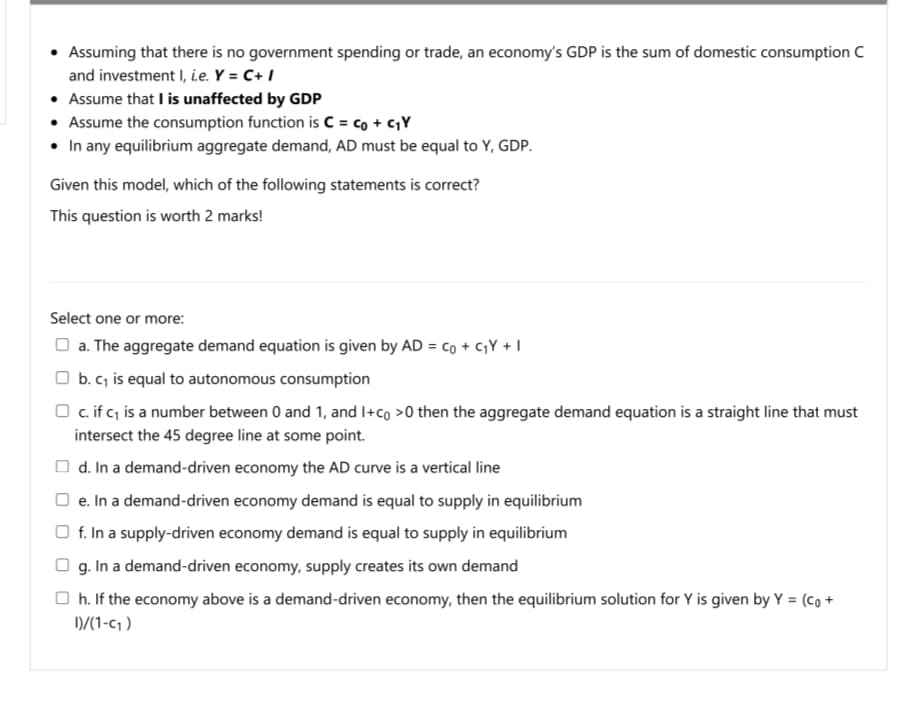• Assuming that there is no government spending or trade, an economy's GDP is the sum of domestic consumption C and investment I, i.e. Y = C+ I • Assume that I is unaffected by GDP • Assume the consumption function is C = co + c,Y • In any equilibrium aggregate demand, AD must be equal to Y, GDP. Given this model, which of the following statements is correct? This question is worth 2 marks! Select one or more: O a. The aggregate demand equation is given by AD = co + CY +I O b. c is equal to autonomous consumption O c.if c is a number between 0 and 1, and I+co >0 then the aggregate demand equation is a straight line that must intersect the 45 degree line at some point. O d. In a demand-driven economy the AD curve is a vertical line O e. In a demand-driven economy demand is equal to supply in equilibrium O f. In a supply-driven economy demand is equal to supply in equilibrium O g. In a demand-driven economy, supply creates its own demand O h. If the economy above is a demand-driven economy, then the equilibrium solution for Y is given by Y = (Co+ D/(1-c1 )
• Assuming that there is no government spending or trade, an economy's GDP is the sum of domestic consumption C and investment I, i.e. Y = C+ I • Assume that I is unaffected by GDP • Assume the consumption function is C = co + c,Y • In any equilibrium aggregate demand, AD must be equal to Y, GDP. Given this model, which of the following statements is correct? This question is worth 2 marks! Select one or more: O a. The aggregate demand equation is given by AD = co + CY +I O b. c is equal to autonomous consumption O c.if c is a number between 0 and 1, and I+co >0 then the aggregate demand equation is a straight line that must intersect the 45 degree line at some point. O d. In a demand-driven economy the AD curve is a vertical line O e. In a demand-driven economy demand is equal to supply in equilibrium O f. In a supply-driven economy demand is equal to supply in equilibrium O g. In a demand-driven economy, supply creates its own demand O h. If the economy above is a demand-driven economy, then the equilibrium solution for Y is given by Y = (Co+ D/(1-c1 )
Chapter18: The Keynesian Model
Section: Chapter Questions
Problem 9SQP
Related questions
Question

Transcribed Image Text:Assuming that there is no government spending or trade, an economy's GDP is the sum of domestic consumption C
and investment I, i.e. Y = C+ I
• Assume that I is unaffected by GDP
• Assume the consumption function is C = co + c,Y
• In any equilibrium aggregate demand, AD must be equal to Y, GDP.
Given this model, which of the following statements is correct?
This question is worth 2 marks!
Select one or more:
O a. The aggregate demand equation is given by AD = co + cY + I
O b. c, is equal to autonomous consumption
O c.if c; is a number between 0 and 1, and I+co >0 then the aggregate demand equation is a straight line that must
intersect the 45 degree line at some point.
O d. In a demand-driven economy the AD curve is a vertical line
O e. In a demand-driven economy demand is equal to supply in equilibrium
O f. In a supply-driven economy demand is equal to supply in equilibrium
O g. In a demand-driven economy, supply creates its own demand
O h. If the economy above is a demand-driven economy, then the equilibrium solution for Y is given by Y = (Co +
D/(1-c1 )
Expert Solution
This question has been solved!
Explore an expertly crafted, step-by-step solution for a thorough understanding of key concepts.
Step by step
Solved in 2 steps

Knowledge Booster
Learn more about
Need a deep-dive on the concept behind this application? Look no further. Learn more about this topic, economics and related others by exploring similar questions and additional content below.Recommended textbooks for you



